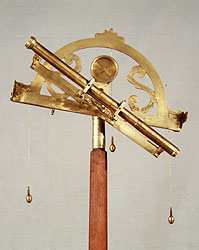 81. Graphometer by P. Carré
81. Graphometer by P. Carré
The instrument is complete with all its accessories: two telescopes with optical parts, wooden tripod with brass tips, three small brass acorns with original threads for setting it up, double bottom wooden case, covered in velvet on the inside, in skin on the outside.
On the embellishment at the top of the limb can be read the signature of Paul Carré. A compass set in the fixed semicircle served to orient it; two pairs of pinnules were used for sighting with the naked eye. There were special screws for regulating the axis of the telescope and getting it parallel to that of the instrument. On each of the telescopes is a cross-wire micrometer to improve measurement of the angles. It can measure angles horizontally and vertically; the Tychonic scale engraved on the limb is accurate to a sixth of a degree, i.e. ten arcminutes.
The fact that there were at one and the same time two ways of measuring, one with the naked eye, the other with the telescope, is proof that the passage from one system of measurement to the other, after the invention of the telescope, was not so sudden as might be thought.
J.A. Bennett (1987), pp. 50-75.
M. Daumas (1953).
F. Farinelli (1979), p. 191.
M. Holbrook (1992), pp. 35 and 74.
G. L’E. Turner (1991), p. 198.